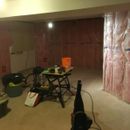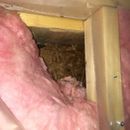Renovation of basement with batt insulation and poly – worth it to add rigid insulation?
Hey all,
I know in new construction that batt insulation and poly is frowned upon nowadays, but I’m working with my basement that is already finished.
It’s a walkout, and the house is approx. 30 years old, and I’ve been here for 3 years. The basement can get pretty humid, but there are no signs of any water damage anywhere but the previous owners had carpet directly on the slab…
So I’ve just started a renovation for an eventual family/tv room. The plan was to put in a floor — rigid foam, plywood with Tapcons — refinish the floors, and done!
One thing led to another, (found PL all over the drywall under wainscotting, realized the enitre room was wallpaper that had been painted over, and realized i needed to run a bunch of speaker, power, cat5 cables) and now I have the drywall off.
My question is regarding the basement insulation.
pics are here: http://imgur.com/a/IlxoU
On the exterior walls, there are 2×4 framed walls with R12 insulation, behind that there is a 2×6 frame filled with r12 insulation, behind that there is OSB or some type of particle board.
the plan is for me to run my wires, board up the walls and move on with the reno, but I just wanted to see what opinions were here. Would placing rigid foam between the 2×6 studs (against the particle board) be worthwhile? any other suggestions? keeping in mind that there doesnt seem to be any major problems (no signs of water, basement is comfortable temperature year round etc..)
GBA Detail Library
A collection of one thousand construction details organized by climate and house part











Replies
just wanted to attach a picture in case the link is not working above.
Note: i tried to change my username and followed the instructions, but I'm still seeing "user-6833843" maybe it takes some time to make the change?
-Jason
Jason,
The material that you call "particleboard" is actually OSB (oriented strand board). It's a standard material for sheathing.
You didn't mention your geographical location or climate zone; if you provide that information, it can help us give you a better answer.
My first reaction is that this is a judgment call. Pulling everything out and re-doing it the right way would be expensive, and there are no signs of problems. Common sense says, "If it ain't broke, don't fix it."
That said, the materials used to finish this basement are risky, so if conditions change (weather conditions or the rate of water entry), you could always have problems.
Sorry, forgot to mention I'm in southwestern ontario - climate zone 6a.
As you mentioned, if it aint broke dont fix it...I'm leaning against ripping everything out and starting from scratch. With that said, do you think there is any benefit to leaving the studs as is, and placing 2" rigid panels between the studs directly on the OSB, then sealing perimeter with expanding foam? That way, i know there would be a sealed thermal barrier on the wall. Was thinking I could put some batt insulation on top, and then there would be no need for the poly.
-Jason
Cut'n'cobbled foam won't buy you much of anything in actual performance. Yanking the studs and installing 2' of EPS or polyiso against the foundation, then reinstalling the studs turned 90 degrees, with split R13-R15 batts compressed into the 1.5" cavities would be far higher performance. (If the existing batts aren't all moldy, use them to save cash.)
In a zone 6 climate even cheap Type-I EPS in that stackup will perform at about R8.3 during the winter, which has a huge dew-point margin on 1.5" of fiberglass (any density.)